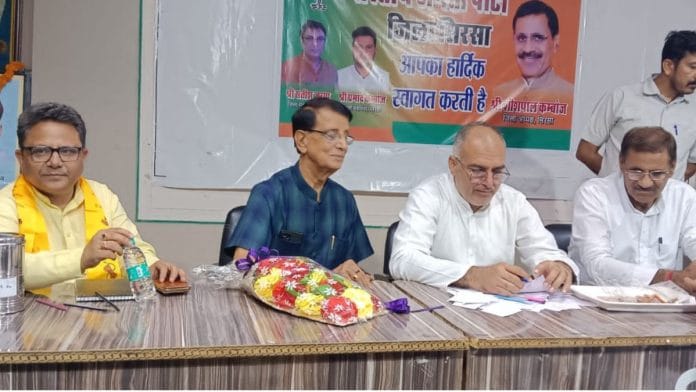Gurugram: Bharatiya Janata Party (BJP) functionaries in Haryana Sunday voted for their choice of MLA candidates for 90 constituencies for the upcoming state assembly elections. This marks the second time the BJP used the technique of US presidential primaries and caucuses to choose MLA candidates; the first time being during the 2022 Himachal Pradesh assembly elections.
US presidential primaries are elections held to nominate presidential candidates, and caucuses are private meetings conducted by political parties themselves to choose candidates through secret ballots.
With the BJP’s internal surveys giving conflicting feedback about candidates in several constituencies in Himachal Pradesh, the party had decided to get its functionaries to recommend candidates through secret ballots. The BJP lost the assembly election though. Given how internal dissensions and party workers’ resentment against candidates had resulted in a setback in the Lok Sabha elections, the BJP decided to involve the workers in candidate selection for Haryana assembly polls, scheduled for October this year.
Sunday’s exercise involved local party leaders and workers, who were asked to vote for the three most suitable candidates in their respective assembly segments.
The BJP leadership plans to use the results of this internal survey to identify the most favoured candidates within the party, given the high number of ticket aspirants across the constituencies. The feedback will also influence future campaign strategies, ensuring that the final candidates have strong internal support to enhance their chances of winning.
Parveen Jorra, a member of the BJP state executive and co-convenor of the party’s legal cell, told ThePrint that the party has taken the opinion of workers in the past too, but this was the first time they were asked to cast votes for ticket aspirants they consider best suited to be fielded from their respective constituencies.
“We were told to write three names of our choice, marking them in the order of preference. The party gave no names from its side. The workers could write names of their choice,” Jorra said.
Also read: BJP is caught in its own Maharashtra trap. It has little to gain in Assembly polls
The selection process
Asked who exactly among the party workers were allowed to cast their votes, Jorra said the party issued a list of office-bearers for this purpose.
The exercise involved local party leaders and workers, who were asked to vote for the three most suitable candidates in their respective assembly segments.
The poll took place at district headquarters, with participation from state, district, and mandal office-bearers, as well as from former MLAs and MPs living in that particular constituency, and representatives of various local bodies.
These included state-level officer-bearers of the BJP’s morchas (fronts); district and mandal presidents of morchas; state and district convenors of prakoshths (cells) and vibhags (departments); BJP councillors and chairpersons of zila parishads; chairpersons and vice-chairpersons of block samitis owing allegiance to BJP. Mayors and BJP corporators of municipal corporations; chairpersons and vice-chairpersons of municipal councils and municipal committees; immediate past district presidents and mandal presidents of the party; and chairpersons and deputy-chairpersons of government boards and corporations residing in the constituency were also included.
Participants were given slips to list their top three candidate preferences, which were then collected for analysis.
“The party assigned the task of holding polls to various senior leaders of the BJP. In Fatehabad, the party sent minister Banwari Lal for this purpose,” Jorra, a resident of Fatehabad, said.
Sanjay Sharma, state spokesperson of the BJP, explained to ThePrint that the polling conducted Sunday was not the sole criterion for the selection of party candidates but one of various criteria.
He added that the aspiring candidate gets 10 points for the first preference, seven for the second and five for the third preference given by voters. The total number of points scored determines their ranking.
Asked what the other criteria were, Sharma said: “Surveys conducted by the party as well as by private agencies deployed by the party, feedback from the RSS and social equations of the constituencies were the other criteria.”
Political analyst Jyoti Mishra, a researcher at the Centre for the Study of Developing Studies (CSDS), told ThePrint that the BJP is leaving no stone unturned in its bid for victory.
“In a strategic move aimed at countering potential anti-incumbency sentiments and gaining a deeper understanding of ground-level dynamics, the BJP has conducted an internal poll among its local party workers and position holders,” Mishra said.
By engaging with its grassroots members and assessing their insights, the BJP hopes to ensure that its candidate selection aligns with the sentiments and preferences of local voters, Mishra said.
This approach reflects the party’s commitment to refining its electoral strategy and enhancing its appeal across Haryana, she said, adding that the BJP’s proactive measures underscore the high stakes of this election for the party, as it seeks to address emerging issues and position itself strongly in the competitive electoral landscape.
(Edited by Radifah Kabir)
Also read: Haryana chief secy Kaushal retires after 4 months’ leave. Surprise over ‘role model’ officer’s exit






